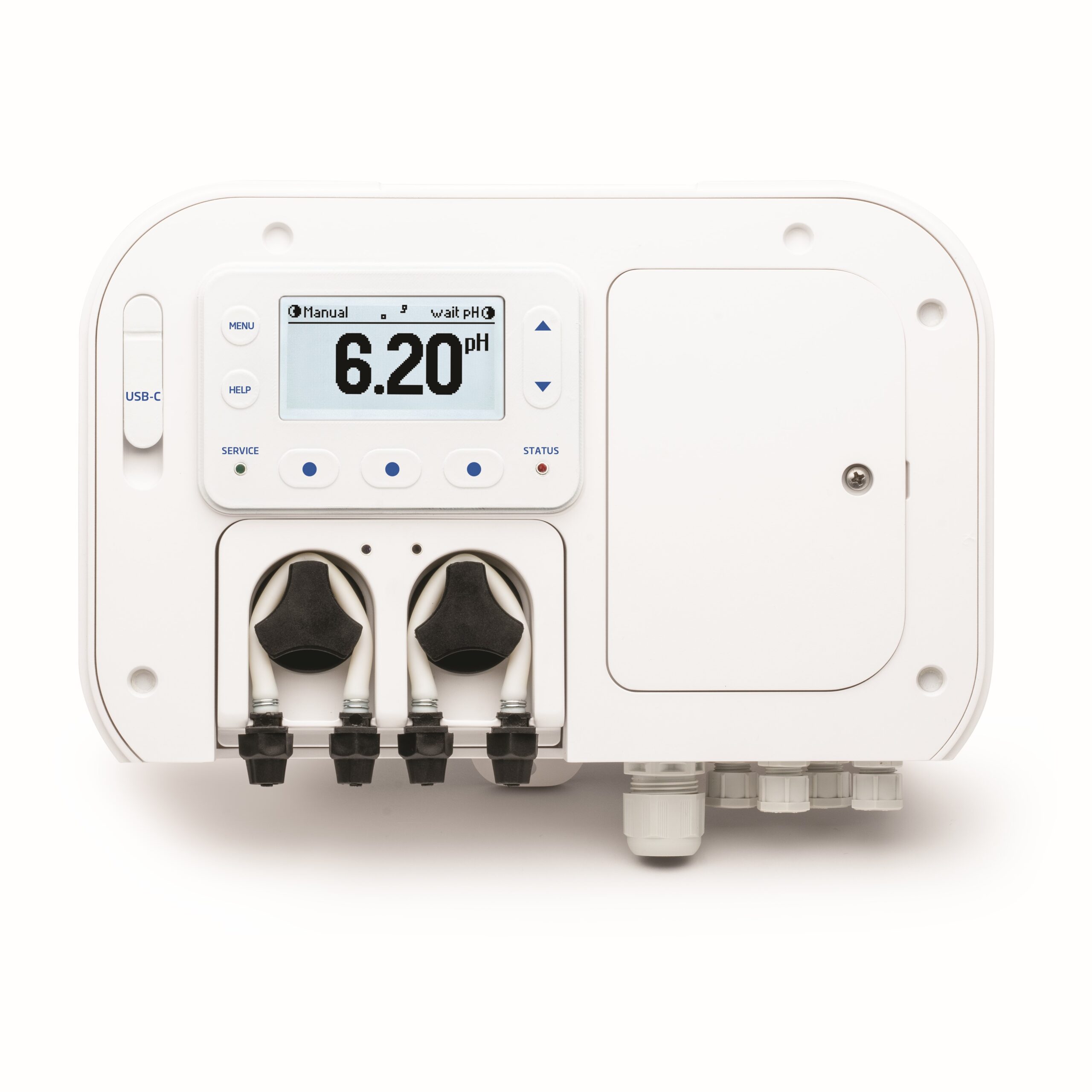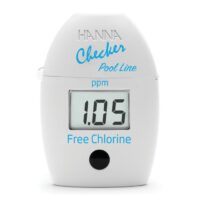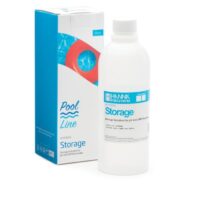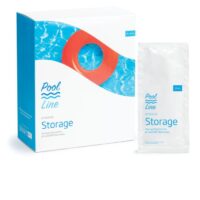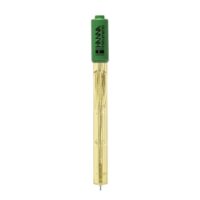The chlorine level is measured based on the ORP or REDOX principle. An increase in the ORP value correlates with an increase in the free-chlorine level. pH and ORP testing are done together for efficient disinfection and control. The efficacy of sanitizers, such as chlorine, depends on a controlled pH value. The ORP value is the most consistent indicator of the sanitizing effectiveness of the pool or spa. Typically, 650-750 mV at 7.2 pH indicates proper water treatment. The controllers offer remote access and visualizing of measured data via Cloud connectivity. All measurements and main events are sent to Hanna Cloud through the Ethernet connection.
The BL131 controllers can be paired with the HI1036-18XX digital probe. The probe incorporates pH, ORP and temperature sensors along with a matching pin. It was specially designed to detect a broken electrode based on a shifted zero potential value, around 4 pH. The HI1036-18XX uses an Ag/AgCl reference with 3.5 M KCl. The ORP values are referenced to it. Measurement data stored on the probe is transferred to the controller via a digital connection; thus eliminating noise and static due to high impedance signals carried by the cable.
Main Features:
• Two built-in peristaltic dosing pumps with Proportional control
• Manual control for pump priming
• Overfeed protection using overtime safety timer
• Resumes dosing on restart in case of power failure
• Level input to stop control without reagents
• Interlocked pH-ORP control (i.e. ORP control only runs when the pH set point has been reached)
• External dosing
• The controller has 2 relays that can be used to control larger external dispensing pumps, allowing the BL131 to be used in larger pools.
• Air temperature sensor
• Allows triggering an alarm if the air temperature is cold enough that there is a risk of water freezing in the pipes (e.g. hot tubs in winter with the circulation pump off)
• Bidirectional control
• User selectable logging interval
• As pool settings normally do not change that quickly, minimize data management by choosing from a wide selection of logging intervals
• Multicolored LED indicators for dosing, meter status and service
• Real-time graph display
• Programmable alarms
• Password protection
Multiple Configurations:
BL131 swimming pool controllers are available in two configurations:
• in-line, for direct probe installation and chemical injection fittings into existing piping
• flow cell, for calibration and probe maintenance without having to shut down the recirculation pump
For compliance monitoring, each of the BL13x family has a built-in datalogger. Measurement reading intervals can be set at 30s/1m/5m/15m/30m/1h, with a new log starting new each day or when the instrument is calibrated. Logged data include pH, ORP, and temperature values, last calibration data, setup configuration, and any event data. The BL13x swimming pool controller is an automatic system, but it is advisable that users check the controller and verify pH and free‑chlorine levels (in mg/L or ppm) in the pool using a portable colorimeter.
Three display modes:
The versatile display of these controllers allows for three display modes. The LCD can display all three parameters at one time, a 3-second cycle of single parameters, or a real-time plot screen with options for parameter selection, zooming, and log recall.

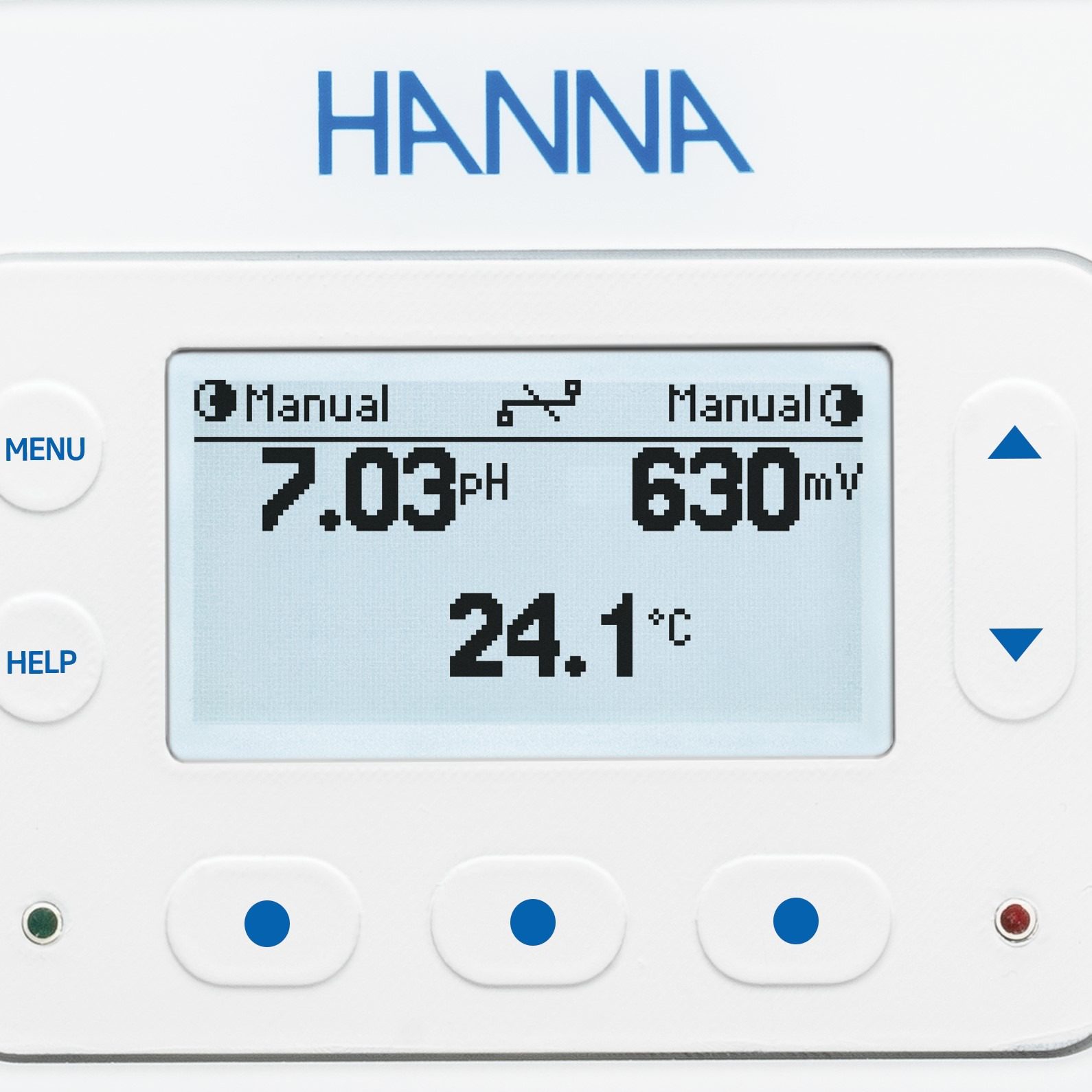

Additional Features:
Peristaltic chemical feed pumps
These controllers are equipped with two peristaltic dosing pumps with replaceable chemical resistant tubing that are proportionally controlled with adjustable flow rates. One of the pumps is used to dose acid or base while the other is used to dose chlorine. The effectiveness of the available chlorine, as determined by ORP, is inversely related to the water’s pH value.
Automatic proportional pump control
BL131 feature proportionally controlled dosing pumps. The user can set the proportional band based on the sensitivity of the process. This setting determines the amount of time that the pumps are dosing as a percentage of the deviation from the set point. For example, a large body of water will use a small proportional band; having a small band (e.g., 0.1 pH) will ensure the pumps are dosing more often when the reading is close to the set point. For smaller bodies of water such as hot tubs or spas, it is more useful to set a larger proportional band (e.g.,1.0 pH); when the reading is close to the set point, the amount of time that the dosing pump is on is minimal to avoid large swings of pH or ORP. This valuable feature allows for very fine control in maintaining the desired set point.
Adjustable flow rate
The dosing pump flow rate is adjustable from 0.5 to 3.5L/h. Larger bodies of water require more chemical to be dosed than small bodies since it takes more chemical to see a change in the reading. The adjustable flow rate, like the proportional band, allows for better control in maintaining a desired set point.
Multicolored LED indicators
The controllers offer multiple LED indicators for status, servicing, and pump operation. The STATUS LED changes color based on operational state; a green LED means the water is within the desired parameter ranges, a yellow LED means that the controller needs attention, and a red LED identifies a problem in the system such as high and low pH, ORP and/or temperature readings. The SERVICE LED indicates attention is required by a service technician.
ORP (chlorine) dosing consent
Both pH and ORP meters are commonly used with swimming pools. With chlorine disinfection there is an inverse relationship between pH and ORP. As the pH level increases, the ORP level decreases. These controllers utilize a dosing consent feature that will not dose chlorine until the pH value is first corrected since it is possible to have a low ORP value even though there is sufficient chlorine. The dosing consent feature prevents waste of chemicals and avoids having a higher chlorine concentration level than desired.
Acid and chlorine tank level inputs
The controllers allow for a connection to an optional level controller. This input is used to disable the dosing pumps when there is no chemical left in the reservoir tank.
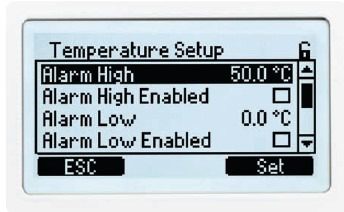
Programmable alarm system
These controllers allow users to enable or disable the low and high level of alarms for all parameters: pH, ORP, and temperature. When an alarm is activated, all dosing will stop. The alarm system also offers overdosing protection in that if the value is not corrected within a specified time interval then the meter will go into alarm status.
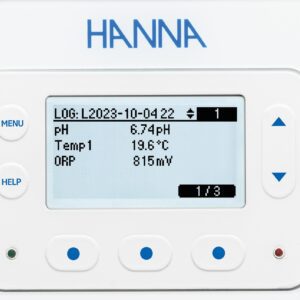
Automatic logging
Measurement readings can be set at 30s/1m/5m/15m/30m/1h intervals. A new log is started each time the instrument is calibrated or at the start of a new day. Logged data includes pH, ORP, and temperature values, last calibration data, setup configuration, and any event data.

GLP
Good Laboratory Practice (GLP) refers to a quality control function used to ensure uniformity of probe calibrations and measurements. GLP stores pH/ORP calibration information including date and time for pH/ORP sensors.
USB connectivity
Easily transfer data to a PC using a flash drive and the USB port.
Hold input
It is possible to connect a flow switch mounted in-line or a mechanical relay that is connected to the recirculation pump power source to the hold input of these controllers. With no flow or when no power is applied to the recirculation pump, the hold circuit will disable the dosing pumps. This will prevent any dosing of chemical when there is no movement of water in the system.
Analog outputs
The BL131 controller offer three 4-20 mA outputs. Each output can be disabled or connected to an external recording device. Each of the three measured parameters (pH, ORP, and temperature) can be assigned to an analog output where the current signal will be proportional to the measured value. For more flexibility and better resolution, the analog output can be scaled; users can define any two points within a parameter range to correspond to the analog output span. For example, the controller assigns 0 pH to 4 mA and 14 pH to 20 mA as a default. The user can adjust the pH range to assign pH 6 to 4 mA and pH 8 to 20 mA. This adjustment allows better resolution in the range of interest.

Password protected
These controllers feature password protection that offers restricted access to calibration, setup, and review of logged data. The password can be set and enabled/disabled during general setup of the instrument.
BL131 & BL132 swimming pool controllers comparison table

Ordering info
In-Line Configuration
BL131-10 is supplied with HI1036-1802 Combined electrode (pH / ORP / Temperature), saddle for electrode, Ø 50 mm pipe (1 pc.), fittings for electrode, injector (2 pcs.), saddle for injectors, Ø 50 mm pipe (2 pcs.), peristaltic pump tubing (2 pcs.), PVC aspiration and injection tubing, 10 m, aspiration filter (2 pcs.), 7.01 pH buffer solution, sachet (3 pcs.), 4.01 pH buffer solution, sachet (3 pcs.), 470 mV ORP test solution, sachet (3 pcs.), power cable, probe quality certificate, instrument quality certificate, quick reference guide with QR code for manual download.
User Panel Flow Cell Configuration
BL131-20 is supplied with HI1036-1802 Combined electrode (pH / ORP /Temperature), panel mounted flow cell, valve for flow cell connections with fittings and tubing, 10 m, injector (2 pcs.), saddle for valves, Ø 50 mm pipe (2 pcs.), saddle for injectors, Ø 50 mm pipe (2 pcs.), peristaltic pump tubing (2 pcs.), PVC aspiration and injection tubing, 10m, aspiration filter (2 pcs.), 7.01 pH Buffer solution, sachet (3 pcs.), 4.01 pH Buffer solution, sachet (3 pcs.), 470 mV ORP test solution, sachet (3 pcs.), power cable, probe quality certificate, instrument quality certificate, quick reference guide with QR code for manual download.
Purchase & Shipping
All prices are inclusive of GST and not all items are stock items, if you require an immediate solution please send an email to sales@hannainst.com.au or call us on (03) 9769 0666.
Free standard delivery: We offer free delivery within Australia on orders over $150, typically arriving within 5 to 7 days. Delivery times may vary depending on the courier service and the recipient’s location. Free shipping is not available with other offers or discounts.
Same-day dispatch: Place your order before 1 PM Monday to Friday for same-day despatch (leaves our warehouse). Delivery times may vary depending on the courier service and the recipient’s location. Subject to stock availability.
Please note that we do not offer shipping to PO Box addresses.

